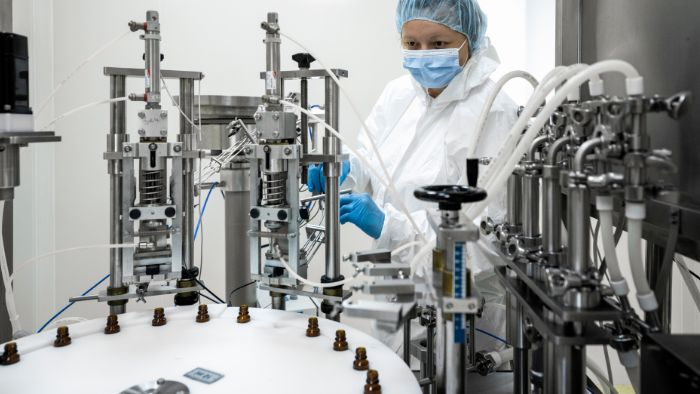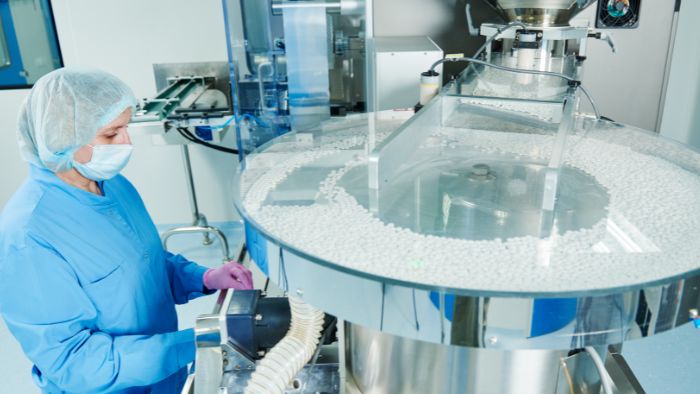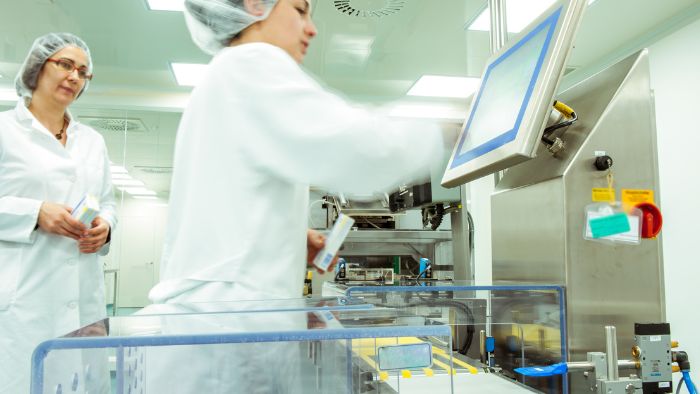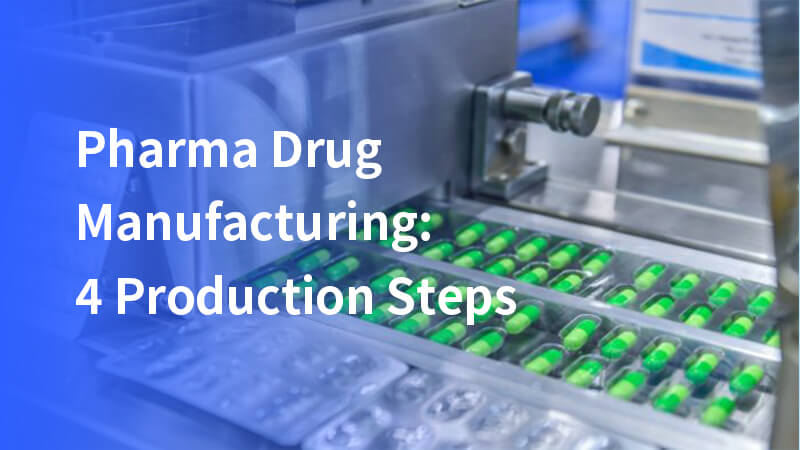As pharma drug manufacturing becomes larger scale and more complex, more and more pharmaceutical companies within the pharma industry are partnering with contract manufacturing and contract development organizations (CMOs and CDMOs) for the ownership and management of their production efforts.

Large drug companies are increasingly using contract partners strategically to fill capacity and expertise gaps to produce their branded drugs. Understanding the steps of drug manufacturing production is very necessary for pharmaceutical companies. Let us introduce them one by one:
Drug mixing in the pharmaceutical industry
For drug mixing, we begin with an already-developed formulation as the initial step in the manufacturing process.
Blend stability in continuous manufacturing
In the mixing process, balance is everything. One must develop a stable and consistent blend that can coexist with the drug without altering or damaging it, ensuring high drug product quality.
The first step?
Determine the batch size, select the appropriate mixer, and calibrate all necessary mixing equipment. With these initial variables set, it’s time to define the preliminary mixing process and select vessels for pre-mixing.
Key considerations
- Ingredient quality: Ensure all ingredients meet the required quality standards and are free from contaminants.
- Importance of APIs: Ensure the quality of active pharmaceutical ingredients (APIs) to support the pharmaceutical industry’s growth in research and development, and to maintain the integrity of both chemical and biological drug substances.
- Accurate measurements: Precisely measure each ingredient to maintain the correct formulation and consistency.
- Equipment calibration: Regularly calibrate blending equipment to ensure accurate and consistent blending processes.
- Homogeneity: Achieve a uniform blend to ensure consistent potency and effectiveness of the final product.
- Environmental controls: Maintain appropriate environmental conditions, such as temperature and humidity, to prevent degradation of ingredients.
- Safety protocols: Follow safety protocols to protect personnel from exposure to hazardous chemical substances.
- Documentation: Keep detailed records of the blending process, including batch numbers, ingredient sources, and any deviations from standard procedures.
- Quality control: Perform regular quality control checks to verify the blend’s consistency and stability.
- Cross-contamination Prevention: Implement measures to prevent cross-contamination between different batches and products.
- Storage conditions: Store blended materials in appropriate conditions to maintain their integrity until further processing.
Medication coating for pharmaceutical products
What follows is a sample of a high-level pharmaceutical coating process for drug products:
- Introduce the blend: Establish parameters for coating temperature, line speed, and thickness to ensure consistency.
- Meter the blend: Accurately apply the blend onto the polymer liner to achieve the desired coating.
- Quality control: Use both inline and manual verification to maintain high standards throughout the process.
- Oven curing: The wet-blend liner is then processed in state-of-the-art ovens to solidify the coating.
- Winding and preparation: The finished laminate is wound and prepared for the next step, ensuring it is ready for subsequent processing.
Common varieties of pharmaceutical coating
The following chart introduces the common types of pharmaceutical coatings, you can view it yourself:
| Category | Type | Drug Release Mechanism/Examples of Medicines | Drug Type | Coating Matrix |
| By Drug Release Mechanism | Controlled Release Coating | Penetration Coating, Dissolution Coating, Diffusion Coating, Ion Exchange Coating | Anti-proliferative Coating, Anti-thrombotic Coating, Anti-infective Coating | Polymer Coating, Lipid Coating, Metal Coating, Ceramic Coating |
| Triggered Release Coating | Temperature Triggered, pH Triggered, Ultrasound Triggered, etc. | Anti-proliferative Coating, Anti-thrombotic Coating, Anti-infective Coating | Polymer Coating, Lipid Coating | |
| By Drug Type | Anti-proliferative Coating | Sirolimus, Paclitaxel, Zotarolimus, etc. | Polymer Coating, Lipid Coating | Drug-coated Stents, Drug-coated Balloons |
| Anti-thrombotic Coating | Heparin, Warfarin, Aspirin, etc. | Polymer Coating, Lipid Coating | Drug-coated Stents, Drug-coated Catheters | |
| Anti-infective Coating | Gentamicin, Rifampicin, Chloramphenicol, etc. | Polymer Coating, Lipid Coating | Drug-coated Implants, Drug-coated Catheters | |
| By Coating Matrix | Polymer Coating | Polyethylene, Polyurethane, Polypropylene, etc. | Anti-proliferative Coating, Anti-thrombotic Coating, Anti-infective Coating | Drug-coated Balloons, Drug-coated Stents, Drug-coated Catheters, Drug-coated Implants |
| Lipid Coating | Phospholipids, Cholesterol, Triglycerides, etc. | Anti-proliferative Coating, Anti-thrombotic Coating, Anti-infective Coating | Drug-coated Balloons, Drug-coated Stents, Drug-coated Catheters | |
| Metal Coating | Cobalt, Chromium, Titanium, etc. | Anti-proliferative Coating, Anti-thrombotic Coating | Drug-coated Stents | |
| Ceramic Coating | Aluminum Oxide, Titanium Nitride, etc. | Anti-proliferative Coating | Drug-coated Implants |
Pharmaceutical serialization
- Product identification: Assign a unique identifier to each product unit, which can be a barcode or a QR code, to ensure traceability throughout the supply chain.
- Data encoding: Encode the unique identifier with relevant product information, such as batch number and expiration date.
- Printing and labeling: Print the encoded information onto labels or directly onto the product packaging.
- Quality verification: Use automated systems to verify the accuracy and readability of the printed identifiers.
- Aggregation: Group serializes units into larger batches (e.g., cases or pallets), and assigns a unique identifier to each batch.
- Data recording: Record all serialization data in a centralized database for tracking and compliance.
- Packaging: Package the serialized products securely to ensure the identifiers remain intact during distribution.

Serialization labels and labeling equipment
After understanding the steps of drug serialization, you may have a certain understanding of serialized labels. Pharmaceutical manufacturers play an important role in ensuring accurate labeling and compliance. The labeling machine plays an important role in this step. The right labeling machine can help your labels adhere to the product without bubbles or wrinkles. Viallabeller is the first choice for labeling equipment. We also provide a series of labeling solutions, such as medicine carton labeling, syringe labeling, ampoule labeling…

Pharma shipping and supply chain
- Finally, you can load the medicines on an industrial scale, but you also need to pay attention to the following points during loading:
- Documentation: Maintain accurate and thorough documentation for all shipments, including invoices, packing lists, and any required regulatory documentation.
- Temperature control: Ensure that products are shipped in temperature-controlled environments to maintain their integrity, particularly for temperature-sensitive medications.
- Regulatory compliance: Adhere to all relevant shipping regulations and guidelines, such as those set by the FDA, EMA, and other regulatory bodies.
- Security: Implement security measures to prevent theft, tampering, and counterfeiting during transit. This can include tamper-evident seals and GPS tracking.
- Inventory management: Use reliable inventory management systems to track shipments in real-time and manage stock levels efficiently.
- Carrier selection: Choose reputable carriers with experience in handling pharmaceutical products to ensure reliable and safe delivery.
- Handling procedures: Train all personnel involved in the shipping process on proper handling procedures to prevent damage and ensure compliance with all safety standards.
- Insurance: Obtain adequate insurance coverage to protect against potential losses or damages during shipping.
- Communication: Maintain clear and continuous communication with all parties involved in the shipping process, including suppliers, carriers, and customers, to ensure a smooth and efficient operation.
Conclusion
In conclusion, the pharmaceutical industry involves a complex process requiring meticulous attention to detail at every step. By partnering with experienced CMOs and CDMOs, pharmaceutical companies can ensure efficient production, from drug mixing and coating to serialization and shipping, ultimately delivering high-quality medications to the market.
References and citations
1. Clive Badman, Why We Need Continuous Pharmaceutical Manufacturing and How to Make It Happen, Elsevier Inc. August 2, 2019. doi:https://doi.org/10.1016/j.xphs.2019.07.016
2. Speck U 1, Stolzenburg N, Peters D, Scheller B, How does a drug-coated balloon work? Overview of coating techniques and their impact.The Journal of Cardiovascular Surgery, 01 Feb 2016, 57(1):3-11,PMID: 26771720
3. Pharmaceutical Drug Serialization: A Comprehensive Review







